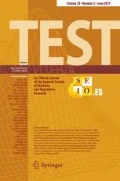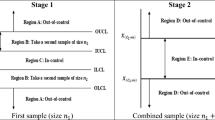Abstract
We develop a theory of stochastic orders for the age and the residual (remaining) lifetime for populations of manufactured identical items. The obtained theoretical results can be used by manufacturers or users for the justified decisions with respect to, e.g., the increase or decrease in the production rate or with respect to the necessary maintenance actions. Specifically, we show that if the random age of a population is smaller (resp. larger) in some stochastic sense than the defined equilibrium age, then it is also smaller (resp. larger) than the corresponding residual lifetime with respect to different stochastic orders. We discuss various stochastic comparisons between the random age and the residual lifetime for one or more populations. Some ageing properties of the random age and the residual lifetime have also been studied.
Similar content being viewed by others
References
Badía FG, Sangüesa C (2008) Preservation of reliability classes under mixture of renewal processes. Probab Eng Inf Sci 22:1–17
Badía FG, Sangüesa C (2015) The DFR property for counting processes stopped at an independent random time. J Appl Probab 52:574–585
Barlow RE, Proschan F (1975) Statistical theory of reliability and life testing. Holt, Rinehart and Winston, New York
Belzunce F (2013) Multivariate comparison of ordered data. In: Li H, Li X (eds) Stochastic orders in reliability and risk. Springer, New York, pp 83–102
Belzunce F, Lillo R, Ruiz JM, Shaked M (2001) Stochastic comparisons of nonhomogeneous processes. Probab Eng Inf Sci 15:199–224
Belzunce F, Martínez-Riquelme C, Mulero J (2015) An introduction to stochastic orders. Academic Press, London
Cai N, Zheng Y (2012) Preservation of generalized ageing class on the residual life at random time. J Stat Plan Inference 142:148–154
Cha JH, Finkelstein M (2016) On stochastic comparisons for population age and remaining lifetime. Stat Pap. doi:10.1007/s00362-016-0759-6
Finkelstein M (2002) Modeling lifetimes with unknown initial age. Reliab Eng Syst Saf 76:75–80
Finkelstein M (2008) Failure rate modeling for reliability and risk. Springer, London
Finkelstein M, Vaupel JW (2015) On random age and remaining lifetime for populations of items. Appl Stoch Models Bus Ind 31:681–689
Karlin S (1968) Total positivity. Stanford University Press, California
Khaledi BE, Shaked M (2010) Stochastic comparisons of multivariate mixture. J Multivar Anal 101:2486–2498
Lai CD, Xie M (2006) Stochastic ageing and dependence for reliability. Springer, New York
Li X, Zuo MJ (2004) Stochastic comparison of residual life and inactivity time at a random time. Stoch Models 20:229–235
Marshall AW, Olkin I (2007) Life distributions. Springer, New York
Nanda AK, Kundu A (2009) On generalized stochastic orders of dispersion-type. Calcutta Stat Assoc Bull 16:241–244
Ross SM (1996) Stochastic processes. Wiley, New York
Shaked M, Shanthikumar JG (2007) Stochastic orders. Springer, New York
Vaupel JW (2009) Life lived and left: Carey’s equality. Demogr Res 20:7–10
Yue D, Cao J (2000) Some results on the residual life at random time. Acta Math Appl Sin 16:436–443
Acknowledgements
The authors would like to thank the associate editor and the anonymous reviewers for their valuable constructive comments which led to an improved version of the manuscript. The first author sincerely acknowledges the financial support from the Claude Leon Foundation, South Africa. The work of the second author was supported by the NRF (National Research Foundation of South Africa) grant IFR 2011040500026. The work of the third author was supported by Priority Research Centers Program through the National Research Foundation of Korea (NRF) funded by the Ministry of Education, Science and Technology (No. 2009-0093827). The work of the third author was also supported by the National Research Foundation of Korea (NRF) grant funded by the Korea government (MSIP) (No. 2016R1A2B2014211).
Author information
Authors and Affiliations
Corresponding author
Rights and permissions
About this article
Cite this article
Hazra, N.K., Finkelstein, M. & Cha, J.H. Stochastic ordering for populations of manufactured items. TEST 27, 173–196 (2018). https://doi.org/10.1007/s11749-017-0539-1
Received:
Accepted:
Published:
Issue Date:
DOI: https://doi.org/10.1007/s11749-017-0539-1




